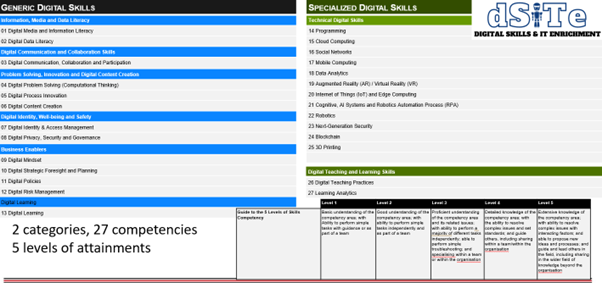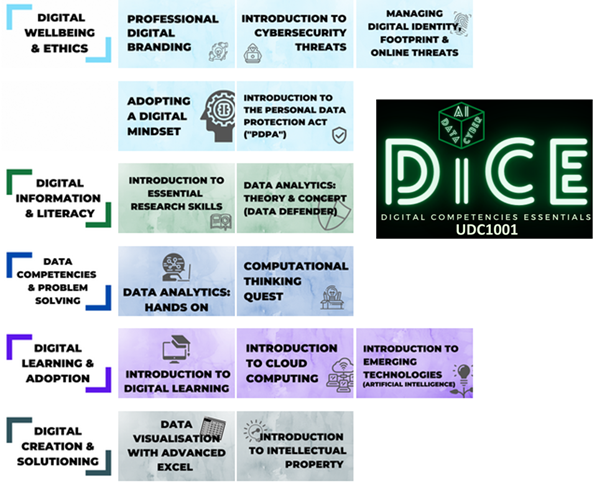
How to develop a digital competency framework everyone can benefit from
As the digitalisation of industry grows, higher education institutions must equip their students with the skills to thrive in the workplace of tomorrow. But this is not an easy task, considering the range of digital competencies that might be required. Rapid change in the technology landscape, which could make course materials outdated before the students even graduate, makes the challenge even more difficult.
- Three approaches to improve your online teaching
- The three stages of developing a framework to support students of open and distance learning
- Digital marketing for universities: strategies for success
At the Singapore Institute of Technology (SIT), we recently embarked on a journey to enhance the digital competencies of our students and academic staff. Here is what we learned.
Designing a framework for developing digital competencies of the students
In Singapore, one of the initiatives under the Ministry of Education’s (MoE) EdTech Masterplan is to strengthen the development of students’ digital literacy and technological skills. MoE also sets forth the digital competency baseline requirements that must be achieved by all graduates from the local higher education institutions.
To fulfil these requirements for our students at SIT, a Digital Competency Framework was developed and implemented as shown in the following diagram:

This framework includes a Digital Competencies Essentials (DiCE) University-Level Module (ULM) that will have to be completed by all students in the university regardless of their discipline. A Digital Skills and IT Enrichment (dSiTe) framework has also been developed, separating digital skills into two categories, generic or specialised; 27 digital competencies, e.g. robotics, mobile computing, blockchain, AR/VR; and five levels of attainment – as follows:

All degree programmes must also include one or more projects for the students to develop and demonstrate some of these specialised technical digital skills. Here is our approach and some of the considerations that were taken in during the implementation of the framework:
The importance of asynchronous online micro-modules: Students across different degree programmes are going to have different study loads and timetables. So, instead of having scheduled face-to-face classes, DiCE is divided into multiple asynchronous online micro-modules, each covering specific digital competency areas as shown in the diagram below. This allows students the flexibility to develop their digital competencies anywhere and anytime across a stipulated period (in our case, the first six trimesters of their degree programmes). Students can personalise their learning plans and develop their digital competencies at their own comfortable pace.
Image
- Supplement online contents with optional face-to-face support: We supplemented micro-modules with face-to-face practical workshops and consultation sessions. But we made them optional, because we felt students with backgrounds in IT or some knowledge already shouldn’t be forced to sit through a workshop they didn’t need.
Targeting the students who felt they needed help meant we could optimise the manpower resources required to support the implementation of the framework.
- Leverage on external resources when possible: You don’t necessarily need to create all the materials for developing digital competencies from scratch, in-house. Many of the major tech companies have established academies with free courseware. These academies also provide free resources and platforms for students to develop their technical skills on (e.g. AWS Educate for cloud skills).
- Develop a systematic improvement cycle to ensure regular updates to the materials: Digital technology advances rapidly, so make sure to update the materials regularly. But also be aware of minimising the disruption to the students who are currently completing existing micro-modules. Take into consideration the following:
- Black out dates to allow for updates to the micro-modules.
- Separate course sites on the Learning Management System (LMS) for each cohort so that major changes to the requirements, such as the insertion or removal of compulsory micro-modules, can be done.
- Establish an Industry Advisory Committee (IAC) as well as a panel of Subject Matter Experts (SMEs) to provide regular validation of the digital competency frameworks and the micro-modules.
- Ensure the digital competencies of the academic staff: Another benefit of developing online asynchronous micro-modules is that these materials could easily be extended to develop the digital competencies of academic staff. For example, to ensure that all SIT academic staff with teaching duties have a minimum baseline digital competency for teaching and learning, they will have to compete the DiCE micro-modules on Adopting a Digital Mindset, Data Analytics, as well as AI within a year of joining the university. They will also have to submit an assignment on how generative AI tools are applied in modules they teach, then submit a reflection on the usage, implementation method, impact and ethical issues, among other topics.
The current pre- and post-assessment results from the development of the digital competency framework are encouraging, with students demonstrating a 23 per cent improvement across all micro-modules taken. The effectiveness of online micro-modules to allow students to learn asynchronously and at their own pace is clear. We will continue to enhance the framework through the systematic improvement cycle, featured above, and will also create more opportunities for students to pick up digital skills at their own pace in the future.
Steven Wong is Director of the Centre for Digital Enablement at the Singapore Institute of Technology.
If you would like advice and insight from academics and university staff delivered direct to your inbox each week, sign up for the Campus newsletter.




